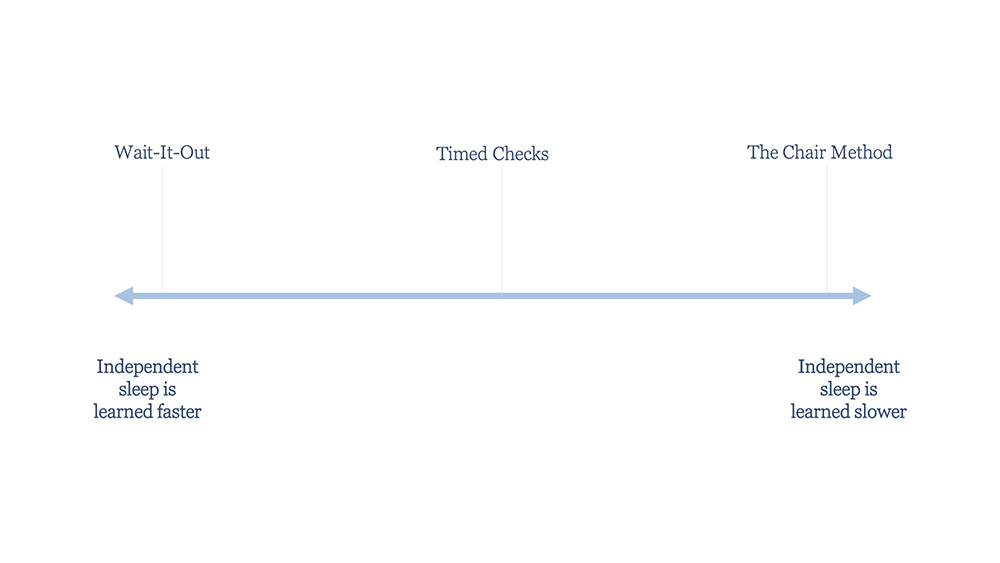Helping your child find their own way to self sooth and fall asleep independently.
One of the most common questions I get asked is, what are my options when it comes to teaching my child to fall asleep without rocking, nursing, swings, bed sharing, or any other sleep crutch. There are various methods all designed to do slightly different things, but most importantly, they all allow your child to discover for themselves, what and how they do best at falling asleep independently. In the newborn stage, babies don’t yet have this ability, but as they grow and develop, we as parents have the tough job of finding the best suited approach to help them develop important new skills, such as sleeping. Just like rolling, sitting up, eating solids, or walking, we can’t do the job for them, but we can encourage their learning and give them the opportunities to learn these skills with our support. Let’s take a look at each method.
In-the-room support
This method, sometimes called the Chair Method, uses your presence as a way to help calm, sooth and support your child through learning to sleep independently. You would remove all sleep crutches, except for your presence in the room, and some gentle guiding words or touch, to help calm and support your child through the process. Every few nights you would move your chair further away from the bed and also begin to decrease the amount of soothing, in order to transfer that skill over to the child. This method can be great for those who have bed shared in the past or who want to be present and feel more connected with their child in the process. The drawbacks are that it’s hard to be consistent with your responses which is a huge component of making things easier on your child. It’s also tough to be within reach of your child as they’re crying, as some children find their parents presence more of a distraction.
Sign Up For Our Newsletter
Interval support
Interval support is a popular method, often referred to as Timed Checks or the Ferber method. Here you support your child’s learning by giving them time and space on their own to work things out, but you’re still able to be more involved by checking in at certain times. This helps children feel supported yet still allows them time to get the hang of falling asleep independently without as much distraction. Many parents start off with this method but soon find that the checks actually disrupt the child’s self-soothing process more than they help. The nice thing about this method is that it’s flexible, so if you notice this, you can check less frequently, or not at all.
Giving them their space
Learning to fall asleep can be pretty tough to do when someone is sitting there next to you, or coming in the room every few minutes to check on you. You may start paying more attention to that person rather than focusing on trying to fall asleep! That’s why some parents prefer this method, often referred to as Wait it Out or Extinction. The difference in this type of support, occurs where you ensure that your child has all of his needs met (fed, changed, not cold/hot, etc.) and they are given their space to cry, roll, suck their thumb, whatever they need to do to figure out what suits them best when it comes to self-soothing and falling asleep on their own. It’s an amazing behavior to watch on the monitor, as you see right before your eyes, your child learn to do something so amazing and important, all on their very own.

How do I know which method is right for my child?
Consider your child’s temperament when choosing a sleep training method. How do they react to your presence? How independent are they? What is their sleep history like? What types of sleep associations do they currently have? Equally important is asking yourself which method could I be 100% consistent with? How involved would my partner be? None of these methods will work if you aren’t consistent, as teaching children in general requires consistency and a clear set of rules and boundaries. When children know what is expected of them, they are primed for a positive learning experience. Children love predictability and patterns. However, if things are constantly changing for the child, it gives them a sense of insecurity and tends to work against us. If you’re stuck or overwhelmed, it’s ok! Many parents feel that way, so enlisting the help of a sleep consultant can give you the reassurance that a custom tailored approach, one that works for your child and family situation, can mean a much smoother process.












